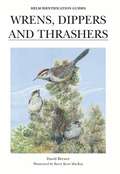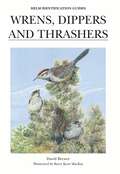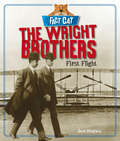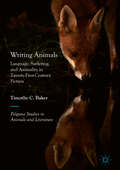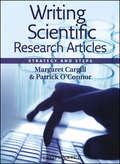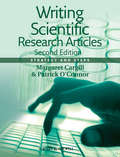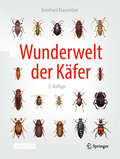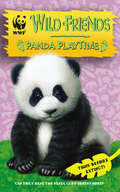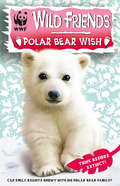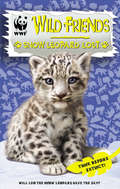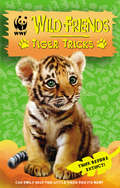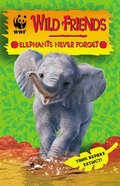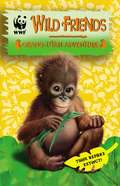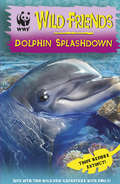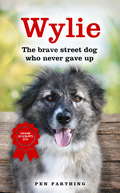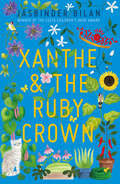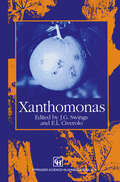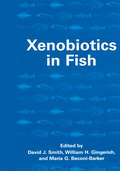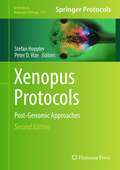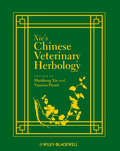- Table View
- List View
Wren (UEB Contracted)
This is an image of a wren (called a winter wren in North America) viewed from the side and facing left so that only one eye and one wing can be found. There is a locator dot shown, which will be at the top left of the page when the image is the right way up. The wren is a very small brown bird in the centre of the page. Its head is on the left of the image with its open brown beak on the left and one of its eyes slightly to the right with a white horizontal marking above it. One of its wings is down and right and above this its erect tail.The wren's two pink legs and feet are at the bottom of the image. Each has three toes pointing to the left and one to the right.
Wren (UEB Uncontracted)
This is an image of a wren (called a winter wren in North America) viewed from the side and facing left so that only one eye and one wing can be found. There is a locator dot shown, which will be at the top left of the page when the image is the right way up. The wren is a very small brown bird in the centre of the page. Its head is on the left of the image with its open brown beak on the left and one of its eyes slightly to the right with a white horizontal marking above it. One of its wings is down and right and above this its erect tail.The wren's two pink legs and feet are at the bottom of the image. Each has three toes pointing to the left and one to the right.
Wrens, Dippers and Thrashers (Helm Identification Guides)
by David Brewer Barry Kent MacKayThis is the first comprehensive guide to these closely related families. The book covers all 75 wrens, 34 thrashers and 5 dippers, almost all of which are New World species. The wrens (Troglodytidae) in particular display great diversity, occupying almost every kind of habitat in the Americas. The family probably originates in Central America where the greatest number of species is to be found. The thrashers (Mimidae) include the mockingbirds, catbirds and tremblers. The dippers (Cinclidae) are river specialists although, unusually, they exhibit no obvious features for an aquatic existence.
Wrens, Dippers and Thrashers: A Guide To The Wrens, Dippers And Thrashers Of The World (Helm Identification Guides)
by David Brewer Barry Kent MacKayThis is the first comprehensive guide to these closely related families. The book covers all 75 wrens, 34 thrashers and 5 dippers, almost all of which are New World species. The wrens (Troglodytidae) in particular display great diversity, occupying almost every kind of habitat in the Americas. The family probably originates in Central America where the greatest number of species is to be found. The thrashers (Mimidae) include the mockingbirds, catbirds and tremblers. The dippers (Cinclidae) are river specialists although, unusually, they exhibit no obvious features for an aquatic existence.
The Wright Brothers: History: The Wright Brothers (library Ebook) (Fact Cat: History #2)
by Jane BinghamRead all about the Wright Brothers, find out about their childhoods and follow their early tests and experiments. Learn all about the brothers' first flight and see how their invention changed the world.A simple fun picture quiz helps readers to recall what they have read.A perfect one-stop-shop for help with homework assignments!Broad-ranging appeal for nursery age through to Key Stage 2.
Writing Animals: Language, Suffering, and Animality in Twenty-First-Century Fiction (Palgrave Studies in Animals and Literature)
by Timothy C. BakerThis book surveys a broad range of contemporary texts to show how representations of human-animal relations challenge the anthropocentric nature of fiction. By looking at the relation between language and suffering in twenty-first-century fiction and drawing on a wide range of theoretical approaches, Baker suggests new opportunities for exploring the centrality of nonhuman animals in recent fiction: writing animal lives leads to new narrative structures and forms of expression. These novels destabilise assumptions about the nature of pain and vulnerability, the burden of literary inheritance, the challenge of writing the Anthropocene, and the relation between text and image. Including both well-known authors and emerging talents, from J.M. Coetzee and Karen Joy Fowler to Sarah Hall, Alexis Wright, and Max Porter, and texts from experimental fiction to work for children, Writing Animals offers an original perspective on both contemporary fiction and the field of literary animal studies.
Writing Scientific Research Articles: Strategy and Steps
by Margaret Cargill Patrick O'Connor"Margaret Cargill's background as a linguist and research communications educator and Patrick O'Connor's experience as both research scientist and educator synergize to improve both the science and art of scientific writing. If the authors' goal is to give scientists the tools to write and publish compelling, well documented, clear narratives that convey their work honestly and in proper context, they have succeeded admirably." Veterinary Pathology, July 2009 "[The book is] clearly written, has a logical step-by-step structure, is easy to read and contains a lot of sensible advice about how to get scientific work published in international journals. The book is a most useful addition to the literature covering scientific writing." Aquaculture International, April 2009 Writing Scientific Research Articles: Strategy and Steps guides authors in how to write, as well as what to write, to improve their chances of having their articles accepted for publication in international, peer reviewed journals. The book is designed for scientists who use English as a first or an additional language; for research students and those who teach them paper writing skills; and for early-career researchers wanting to hone their skills as authors and mentors. It provides clear processes for selecting target journals and writing each section of a manuscript, starting with the results. The stepwise learning process uses practical exercises to develop writing and data presentation skills through analysis of well-written example papers. Strategies are presented for responding to referee comments, as well as ideas for developing discipline-specific English language skills for manuscript writing. The book is designed for use by individuals or in a class setting. Visit the companion site at www.writeresearch.com.au for more information.
Writing Scientific Research Articles: Strategy and Steps
by Margaret Cargill Patrick O'ConnorThis book shows scientists how to apply their analysis and synthesis skills to overcoming the challenge of how to write, as well as what to write, to maximise their chances of publishing in international scientific journals. The book uses analysis of the scientific article genre to provide clear processes for writing each section of a manuscript, starting with clear ‘story’ construction and packaging of results. Each learning step uses practical exercises to develop writing and data presentation skills based on reader analysis of well-written example papers. Strategies are presented for responding to referee comments, and for developing discipline-specific English language skills for manuscript writing and polishing. The book is designed for scientists who use English as a first or an additional language, and for individual scientists or mentors or a class setting. In response to reader requests, the new edition includes review articles and the full range of research article formats, as well as applying the book’s principles to writing funding applications. Web support for this book is available at www.writeresearch.com.au
Writing Scientific Research Articles: Strategy and Steps
by Margaret Cargill Patrick O'Connor"Margaret Cargill's background as a linguist and research communications educator and Patrick O'Connor's experience as both research scientist and educator synergize to improve both the science and art of scientific writing. If the authors' goal is to give scientists the tools to write and publish compelling, well documented, clear narratives that convey their work honestly and in proper context, they have succeeded admirably." Veterinary Pathology, July 2009 "[The book is] clearly written, has a logical step-by-step structure, is easy to read and contains a lot of sensible advice about how to get scientific work published in international journals. The book is a most useful addition to the literature covering scientific writing." Aquaculture International, April 2009 Writing Scientific Research Articles: Strategy and Steps guides authors in how to write, as well as what to write, to improve their chances of having their articles accepted for publication in international, peer reviewed journals. The book is designed for scientists who use English as a first or an additional language; for research students and those who teach them paper writing skills; and for early-career researchers wanting to hone their skills as authors and mentors. It provides clear processes for selecting target journals and writing each section of a manuscript, starting with the results. The stepwise learning process uses practical exercises to develop writing and data presentation skills through analysis of well-written example papers. Strategies are presented for responding to referee comments, as well as ideas for developing discipline-specific English language skills for manuscript writing. The book is designed for use by individuals or in a class setting. Visit the companion site at www.writeresearch.com.au for more information.
Writing Scientific Research Articles: Strategy and Steps
by Margaret Cargill Patrick O'ConnorThis book shows scientists how to apply their analysis and synthesis skills to overcoming the challenge of how to write, as well as what to write, to maximise their chances of publishing in international scientific journals. The book uses analysis of the scientific article genre to provide clear processes for writing each section of a manuscript, starting with clear ‘story’ construction and packaging of results. Each learning step uses practical exercises to develop writing and data presentation skills based on reader analysis of well-written example papers. Strategies are presented for responding to referee comments, and for developing discipline-specific English language skills for manuscript writing and polishing. The book is designed for scientists who use English as a first or an additional language, and for individual scientists or mentors or a class setting. In response to reader requests, the new edition includes review articles and the full range of research article formats, as well as applying the book’s principles to writing funding applications. Web support for this book is available at www.writeresearch.com.au
WTF, Evolution?!: A Theory of Unintelligible Design
by Mara GrunbaumWe all have our off days. Why should Evolution be any different? Maybe Evolution got carried away with an idea that was just a little too crazy—like having the Regal Horned Lizard defend itself by shooting three-foot streams of blood from its eyes. Or maybe Evolution ran out of steam (Memo to Evolution: The Irrawaddy Dolphin looks like a prototype that should have been left on the drawing board). Or maybe Evolution was feeling cheeky—a fish with hands? Joke’s on you, Red Handfish! Or maybe Evolution simply goofed up: How else to explain the overgrown teeth of the babirusas that curl backward over their face? Oops. Mara Grunbaum is a very smart, very funny science writer who celebrates the best—or, really, the worst—of Evolution’s blunders. Here are more than 100 outlandish mammals, reptiles, insects, fish, birds, and other creatures whose very existence leaves us shaking our heads and muttering WTF?! Ms. Grunbaum’s especially brilliant stroke is to personify Evolution as a well-meaning but somewhat oblivious experimenter whose conversations with a skeptical narrator are hilarious. For almost 4 billion years, Evolution has produced a nonstop parade of inflatable noses, bizarre genitalia, and seriously awkward necks. What a comedian!
Wunderwelt der Käfer
by Bernhard KlausnitzerBegeben Sie sich auf eine Expedition in den Mikrokosmos der Käfer. Die Neuauflage dieses opulenten Bildbandes gibt einen umfassenden Überblick über die bizarre Wunderwelt dieser besonderen, artenreichsten Insektenordnung. Reichlich illustriert befasst sich das Buch damit, wie die Käfer schon früh in der Kulturgeschichte des Menschen das künstlerische Schaffen, ja sogar Poeten und Maler inspiriert haben. In Kapiteln über Körperbau, Stammesgeschichte, extreme Lebensräume, körperliche und physiologische Spitzenleistungen und über das unglaubliche Verhalten der Käfer erfährt der Leser viele beeindruckende Fakten und Hintergründe. Ebenso faszinierend wie die vielfältigen Ernährungs- und Lebensweisen sind Nutzen und Schäden, die Käfer verursachen, sowie ihre Rolle in der Volksmedizin. Leicht verständlich und unterhaltsam weckt dieses Buch Begeisterung für die Bedeutung und Schönheit der Käferwelt. Die 3. Auflage ist um ein neues Vorwort und auch ein Nachwort ergänzt, um auf aktuelle Entwicklungen hinzuweisen.
WWF Wild Friends: Book 1
by Linda ChapmanEight-year-old Emily's parents are travelling to the remote Chinese jungle to carry out some important work for WWF – and Emily's getting to go along too! A greedy businessman is threatening to build a new hotel on a reserve that's home to a family of Giant Pandas, and it's up to Emily's mum and dad to stop him. When she meets adorable baby panda cub, Li, Emily is even more determined to help protect his home and family. But will she be able to find the other pandas in time to save the reserve?
WWF Wild Friends: Book 3
by Linda ChapmanEmily's off to a winter wonderland – the Arctic Circle! Will she catch a glimpse of a polar bear? With the polar bear's home melting fast, the frozen north is becoming a difficult place to raise their young - and a tiny polar bear cub, lost on the sea ice, needs Emily's help to find its mother again. Can Emily reunite Snowy with his mother and make all their Christmas wishes come true?
WWF Wild Friends: Book 4
by Linda ChapmanEmily's dad is in Mongolia, helping to set up a new project to help endangered snow leopards in the area. When Emily goes to visit him at half term, she can't believe her luck when she makes friends with adorable snow leopard cub, Leo. But not everyone is as pleased that the leopards are making themselves at home. With the help of local boy Bataar, can Emily show the villagers that there's a way to live peacefully with the leopards?
WWF Wild Friends: Book 2
by Linda ChapmanEmily's mum is being sent to India to take photos of an endangered forest. Emily isn't expecting to meet any wild friends, so is delighted when runaway tiger cub, Bala, turns up! But the local people are less happy to see her. Can Emily help Bala find her mother, before she's forced to fend for herself in the wild?
WWF Wild Friends: Book 5
by Linda Chapman Michelle MisraThe fifth title in this utterly adorable series. When Emily finds an old photo of a little girl and a baby elephant playing together, she's amazed to discover that the little girl is her! The elephant in question has now grown up, and is living in Kenya's most famous national park, the Maasai Mara - so when Emily's parents plan a trip to Africa, she's determined to find her very first wild friend. Is the saying "an elephant never forgets" really true? Will Kihari remember Emily too?
WWF Wild Friends: Book 6
by Linda Chapman Michelle MisraThe sixth title in this brilliant new series for animal lovers everywhere!Emily's dad has been setting up a new project to help protect the orang-utans in Borneo. When Emily goes to visit she finds herself a brand new wild friend - baby orang-utan Koyah. When Koyah's tree-top home is threatened by illegal loggers, Emily vows to find a way to stop them. Can Emily save Koyah in time?
WWF Wild Friends: Book 7
by Linda Chapman Michelle MisraThe seventh title in this utterly adorable, totally WILD fiction series.Emily's fun-filled summer holiday in Florida is cut short when her mum gets an urgent call from the WWF. Soon they are exploring the Mexican coast, where Emily meets a new wild friend - baby dolphin Coral! But danger is just around the corner. Can Emily save Coral in time?
Wylie: The Brave Street Dog Who Never Gave Up
by Pen Farthing'When people gave up on Wylie, Wylie refused to give up on people.'For a street dog born in the city of Kandahar, Afghanistan, to be crowned top dog at Scruffts, a competition for crossbreeds held during Crufts, the largest dog show on earth, is nothing short of a miracle. But for Wylie, the gentle, cropped eared ball of fur, miracles seemed to happen quite regularly. Beaten and abused while being used as a bait dog, Wylie suffered terrible injuries that needed urgent treatment. Rescued close to death, with hacked off ears and a severed tail, he was attended to by soldiers who feared he would not last the night. Astonishingly he did, only to return days later with new injuries. However a lifeline came when he was handed over to animal welfare Charity Nowzad and flown to Britain in the hope of finding a new life. But would anyone take a chance on a seemingly nervous and undomesticated stray? Luckily for Wylie his biggest adventure yet was about to begin...This is the incredible and heart-warming story, full of tragedy and triumph, of a dog who never gave up hope.
Xanthe And The Ruby Crown
by Jasbinder BilanXanthe loves visiting her Nani in her tower block flat. Then, Nani is diagnosed with dementia. Xanthe is determined to help but doesn’t know how – until a mysterious cat leads the way to the truth about Nani’s refugee past …
Xenobiotics in Fish
by D. J. Smith William H. Gingerich Maria G. Beconi-BarkerAquaculture is rapidly becoming a major source of fish protein used to meet the nutritional needs of humans. As the aquaculture industry grows, exposure of farmed fish to environmental contaminants, and the need for chemical therapeutic agents for fish, will increase. This book is designed to bring together authorities worldwide on the regulation of environmental contaminants and food chemicals and researchers investigating the metabolism and disposition of foreign chemicals (xenobiotics) in fish species.
Xenopus Protocols: Post-Genomic Approaches (Methods in Molecular Biology #917)
by STEFAN HOPPLER and Peter D VizeDuring the 20th century Xenopus has flourished as an accessible experimental model system for studying vertebrate biology. The second edition of Xenopus Protocols:Post-Genomic Approaches expands upon the previous edition with novel approaches inspired by Xenopus tropicalis and the sequencing of its genome. Xenopus tropicalis genomics and tractable genetics combined with the unique experimental advantages of Xenopus laevis and their distinctive phylogenetic position make them unique model systems for vertebrate embryonic development in the 21st century. Written in the highly successful Methods in Molecular Biology™ series format, chapters include introductions to their respective topics, lists of the necessary materials and reagents, step-by-step, readily reproducible laboratory protocols, and key tips on troubleshooting and avoiding known pitfalls. Authoritative and practical, Xenopus Protocols: Post-Genomic Approaches, Second Edition provides a toolkit that will enable every laboratory to maximize the power of this extraordinary experimental system in the post-genomic age.
Xie's Chinese Veterinary Herbology
by Huisheng Xie Vanessa PreastXie's Chinese Veterinary Herbology serves as a practical guide to the theory and application of Chinese Herbal Medicine into veterinary practices. Divided into three parts, the book covers herbal materia medica used in treating various disorders and diseases, herbal formulas, and the clinical application of treatments. The book also outlines each herb's history, the formulation of herbal recipes, energetic actions, indications and contraindications of each formula, dosages, and clinical and pharmacological studies performed with herbal treatments. This text serves as an invaluable reference to veterinarians looking to expand treatment options.

